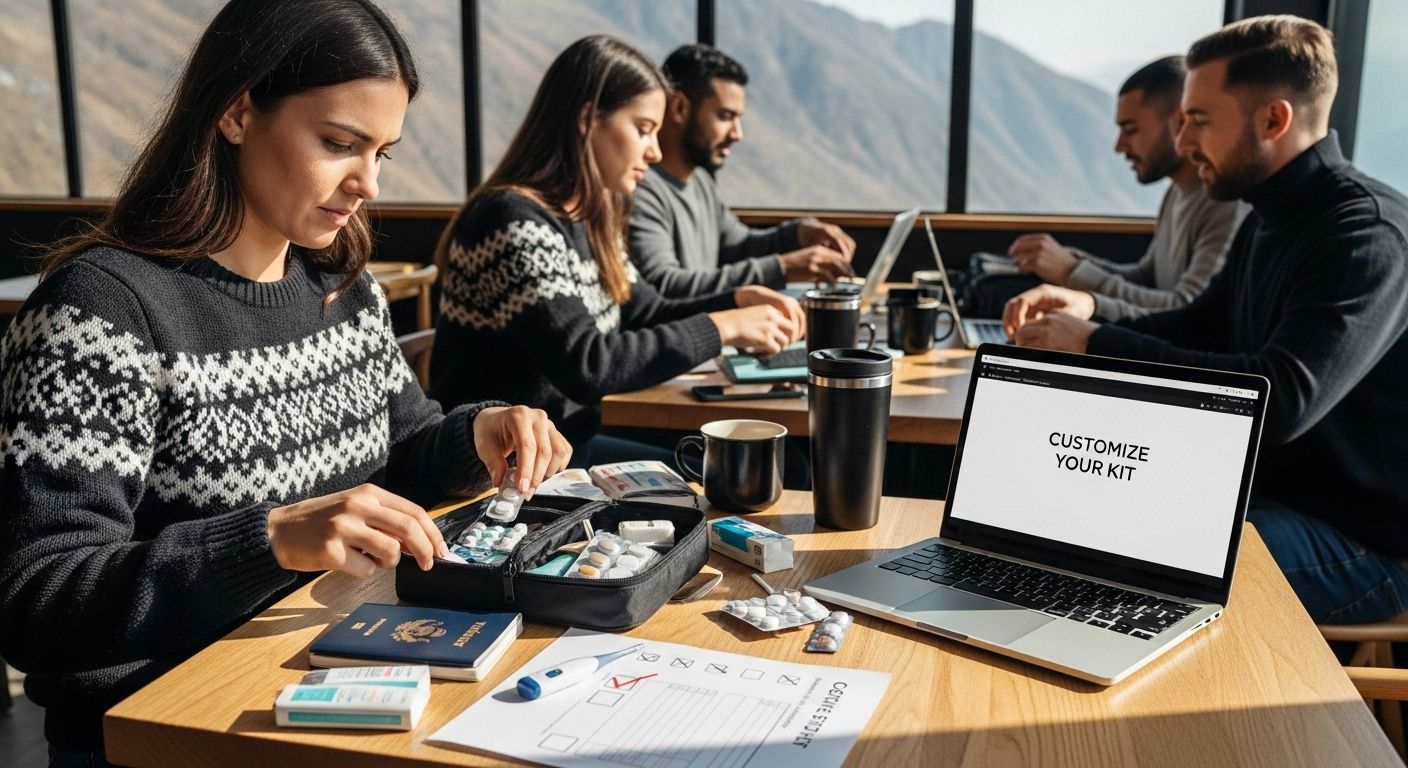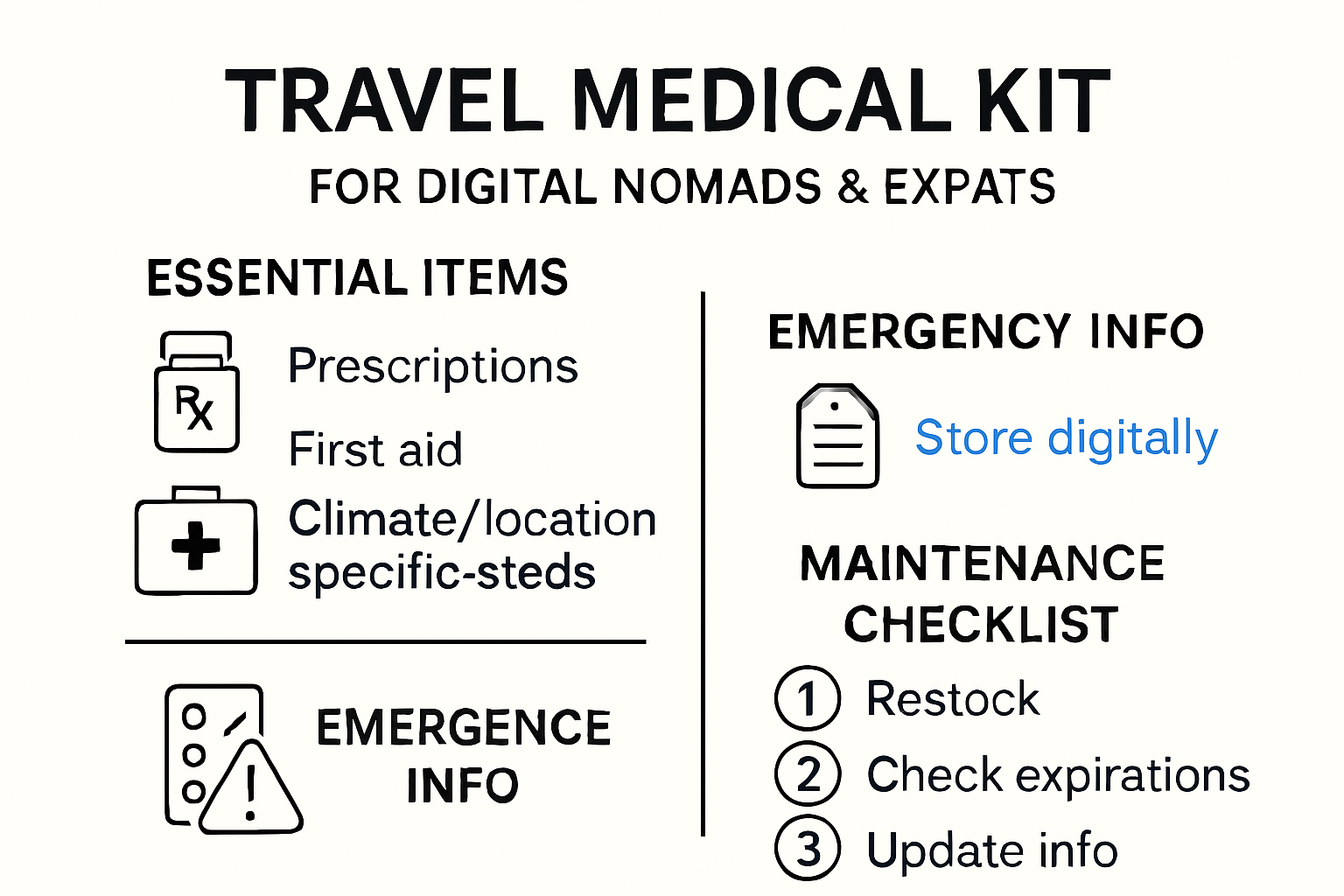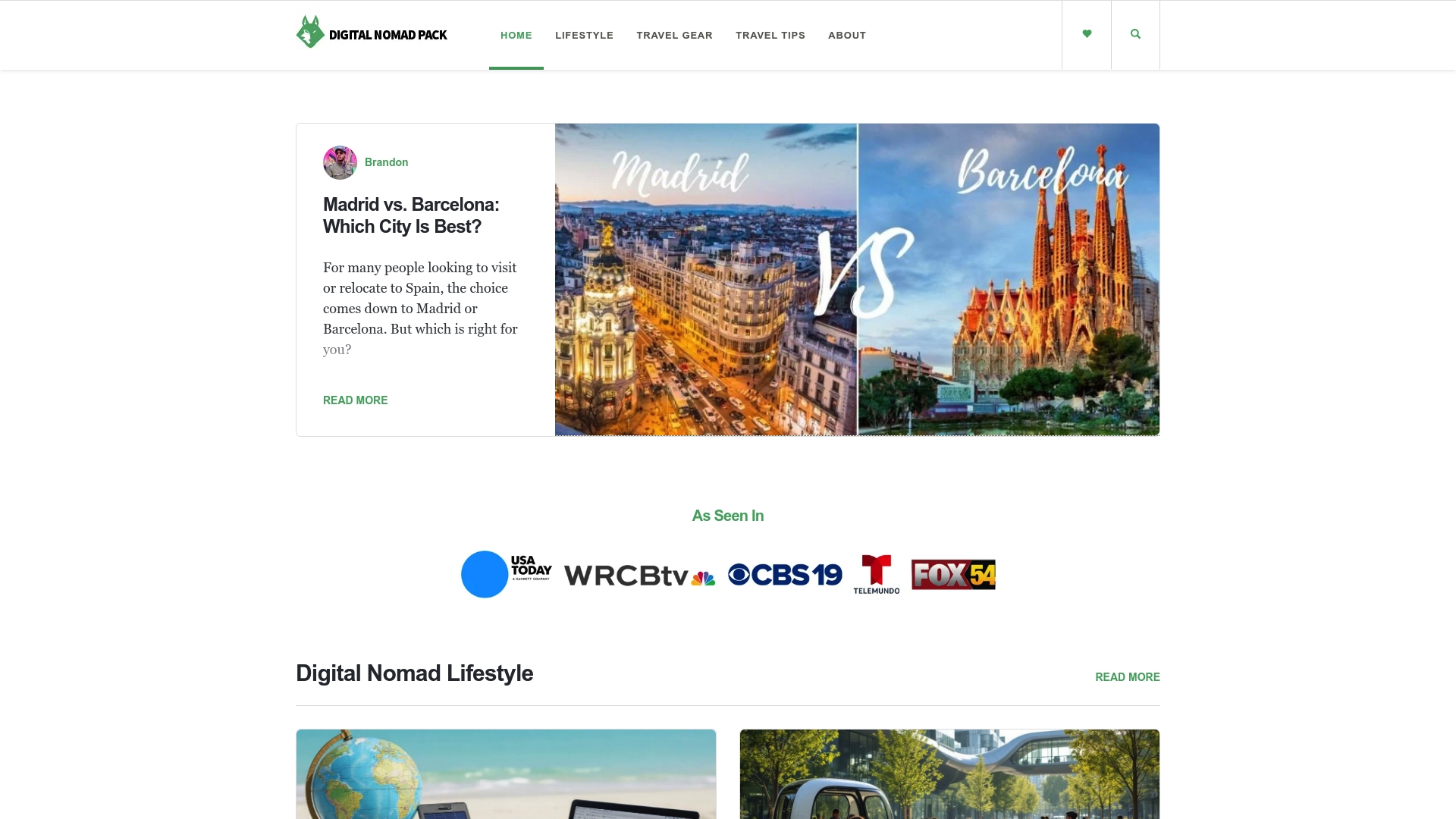Travel Medical Kit Essentials for Digital Nomads and Expats
Packing for a new country is never just about clothes and gadgets. Health surprises can hit when you least expect them and about 30 percent of travelers report getting sick during their trips according to recent studies. Most people think a few painkillers and bandages will do the trick. The real difference comes from a custom travel medical kit built for your lifestyle and destination—and it can save more than just your vacation.
Quick Summary
| Takeaway | Explanation |
|---|---|
| Essential medications are crucial | Always pack a week’s extra supply of prescription medications in original containers to avoid issues during travel disruptions. |
| Customize your kit for activities | Tailor medical supplies based on specific travel activities, like altitude or tropical conditions, to address unique health challenges. |
| Regularly maintain your kit | Conduct routine inventories of your medical kit, replacing expired items and ensuring adequate supplies for your travel needs. |
| Digital documentation is vital | Back up important medical information digitally, including prescriptions and emergency contacts, for easy access while traveling. |
| Adopt smart packing strategies | Use labeled, waterproof containers for organizing supplies, enhancing visibility and accessibility during emergencies. |
Why Every Traveler Needs a Medical Kit
Traveling introduces unpredictable health challenges that can quickly transform an exciting adventure into a stressful medical emergency. Digital nomads and expats face unique health risks when moving across different environments, making a comprehensive travel medical kit not just a recommendation, but a critical necessity.
Understanding Travel Health Vulnerabilities
The global landscape of health risks demands proactive preparation. Research from the World Health Organization emphasizes that travelers may encounter various health challenges, including exposure to infectious diseases, dramatic environmental changes, and potential limitations in medical infrastructure. These vulnerabilities are significantly more pronounced for digital nomads who frequently transition between diverse geographical locations.
The Centers for Disease Control and Prevention highlights that unexpected health issues can derail travel plans and professional commitments. For remote workers and digital professionals, a health interruption isn’t just a personal inconvenience—it can mean lost productivity, missed deadlines, and potential financial implications.
Critical Components of Travel Medical Preparedness
A robust travel medical kit transcends basic first aid. It represents a strategic approach to health management while navigating unfamiliar territories. According to medical research published in PubMed, travelers most commonly encounter gastrointestinal problems, respiratory illnesses, and skin conditions that can be effectively managed with proper preparation.
The kit should not merely be a collection of generic medical supplies, but a personalized health safety net tailored to individual medical histories, destination-specific risks, and professional requirements. This means considering factors like chronic medications, potential environmental exposures, and the ability to maintain work productivity even during minor health setbacks.
Moreover, for digital nomads whose entire professional ecosystem depends on consistent performance, a comprehensive medical kit isn’t just about treating illnesses—it’s about preventing disruptions. Whether you’re coding in a Bali co-working space or conducting virtual meetings from a remote mountain town, having immediate access to essential medical supplies can mean the difference between a minor health hiccup and a significant professional interruption.
Preparing a travel medical kit is an investment in personal and professional resilience. It demonstrates foresight, self-care, and a commitment to maintaining peak performance regardless of geographical challenges. Our comprehensive packing guide offers additional insights into creating a travel health strategy that keeps you moving, working, and exploring with confidence.
Must-Have Items for Your Travel Medical Kit
Building a comprehensive travel medical kit requires strategic thinking and meticulous planning. Digital nomads and expats need a carefully curated collection of medical supplies that balance portability, versatility, and effectiveness across diverse travel environments.
To help you quickly identify what to include in your travel medical kit, here’s a summary table organizing must-have items by their main purpose:
| Category | Recommended Items |
|---|---|
| Prescription Medications | Extra 1-week supply in original containers, comprehensive medication list, medical ID card/bracelet |
| First Aid Supplies | Adhesive bandages, antiseptic wipes, tweezers, thermometer, elastic bandages, scissors |
| Specialized Treatments | Blister treatments, hydrocortisone cream, wound closure strips |
| Emergency Supplies | Oral rehydration salts, water purification tablets, emergency blanket |
| Over-the-counter Medications | Pain relievers, anti-diarrheals, antihistamines, motion sickness tablets |
| Location-specific Protection | High-SPF sunscreen, insect repellent with DEET, lip balm with SPF, moisturizing treatments |
| Documentation | Medication list, physician contact info, digital backups |
Prescription and Essential Medications
The Centers for Disease Control and Prevention recommends prioritizing prescription medications as the cornerstone of any travel medical kit. Digital nomads should pack a minimum of one week’s extra medication beyond their planned travel duration, stored in original labeled containers. This preparation protects against unexpected travel delays or disruptions.
Include a comprehensive list of all current medications, including generic names, dosages, and your physician’s contact information. For travelers with chronic conditions, carrying a medical alert card or wearing a medical identification bracelet can provide critical information in emergency situations. Our comprehensive packing guide offers additional strategies for managing medications while traveling.
First Aid and Emergency Supplies
MedlinePlus recommends a diverse range of first aid supplies that go beyond basic bandages. Essential items include sterile adhesive bandages in multiple sizes, antiseptic wipes, tweezers, digital thermometer, elastic bandages, and scissors. Digital nomads should also pack specialized items like blister treatments, hydrocortisone cream for insect bites, and wound closure strips.
Additional critical emergency supplies include oral rehydration salts, water purification tablets, and a small emergency blanket. These items can be lifesavers in remote locations with limited medical infrastructure. Consider including a small supply of pain relievers, anti-diarrheal medication, antihistamines, and motion sickness tablets to address common travel-related health challenges.
Location-Specific and Personal Health Considerations
The World Health Organization emphasizes the importance of tailoring your medical kit to specific destination requirements. Tropical destinations demand additional supplies like high-SPF sunscreen, insect repellent with DEET, and treatments for potential tropical diseases. Cold climates require different protective gear, such as lip balm with sun protection and moisturizing skin treatments.
Personal health considerations are equally important. Travelers with specific medical conditions should consult healthcare professionals about destination-specific health risks and recommended preventive measures. This might include altitude sickness medication for mountain destinations, additional supplies for managing chronic conditions, or specific vaccinations recommended for particular regions.
Ultimately, a well-prepared travel medical kit is more than a collection of supplies—it’s a comprehensive health strategy. By anticipating potential health challenges and preparing accordingly, digital nomads can minimize medical risks and maintain their professional momentum, regardless of geographical location or unexpected health complications.
Customizing Your Kit for Destinations and Lifestyles
Traveling as a digital nomad means adapting your medical kit to the unique challenges of different environments, work styles, and personal health requirements. A one-size-fits-all approach simply doesn’t work when your office can be a beach in Bali or a mountain cafe in Peru.
Activity-Specific Medical Preparations
The CDC’s Yellow Book highlights the critical importance of tailoring medical supplies to specific travel activities and destinations. Adventure-prone digital nomads need to consider more than standard first aid items. For those engaging in high-altitude work or remote location projects, specialized medications become essential. This might include altitude sickness prevention medications for mountain destinations, extra electrolyte solutions for hot climates, or specific treatments for environments with unique health challenges.
Consider your typical work environment and potential physical demands. A digital nomad working from tropical co-working spaces requires different medical preparations compared to someone frequently hiking or working in remote mountain regions. Include items like extra hydration solutions, specific wound care supplies, and medications that address potential environmental health risks specific to your typical work locations.
Medication Management and Safety
The Centers for Disease Control and Prevention provides critical guidance on medication safety during travel. Digital nomads must be particularly vigilant about medication storage and management. This means keeping medications in child-resistant containers, protecting them from extreme temperatures, and maintaining proper documentation.
For those with chronic conditions or specific health needs, creating a comprehensive medication management strategy is crucial. This includes carrying a detailed medication list, keeping prescriptions in original labeled containers, and having digital and physical copies of important medical documents. Consider creating a digital health portfolio that includes medical history, current prescriptions, and emergency contact information accessible from any device.
Lifestyle-Driven Health Preparedness
Your medical kit should reflect the unique intersection of your professional and personal lifestyle. Remote workers with high-stress jobs might include additional stress management supplies like sleep aids, meditation tools, or supplements supporting mental health. Those working in technology-intensive environments might need items addressing digital strain, such as eye drops, ergonomic support items, or supplements supporting extended screen time.
Geographical diversity demands flexible health preparedness. A digital nomad moving between tropical and cold environments needs a medical kit that can adapt quickly. This means including versatile items like multi-climate sunscreen, adaptable pain management solutions, and medications that work effectively across different environmental conditions.
Our guide to sustainable travel offers additional insights into creating a holistic approach to health and travel. Remember, your medical kit is more than a collection of supplies—it’s a personalized health strategy designed to keep you working, exploring, and thriving in an ever-changing global landscape.

Tips for Packing and Maintaining Your Medical Kit
Managing a travel medical kit requires strategic planning, organization, and consistent maintenance. Digital nomads must approach their medical supplies with the same precision they apply to their professional work—thoughtful, adaptive, and meticulously prepared.
Below is a process table outlining essential maintenance steps for keeping your travel medical kit up-to-date and travel-ready:
| Step | Description |
|---|---|
| Organize supplies | Use clear, labeled, waterproof containers for visibility and protection |
| Inventory check | Regularly review kit contents and ensure adequate supply levels |
| Replace expired items | Remove and replace any medications or supplies that are past their expiration date |
| Check climate-sensitive items | Ensure temperature-sensitive medications are still effective and safely stored |
| Update documentation | Create or refresh digital and physical copies of prescriptions, emergency contacts, and medical history |
| Set reminders | Use calendar alerts or travel prep checklists to maintain regular kit upkeep |
| Replenish based on travel | Adjust the contents according to current travel destinations and activities |
Smart Packing and Organization Strategies
The Centers for Disease Control and Prevention recommends a systematic approach to packing medical supplies. Digital nomads should prioritize compact, lightweight containers that protect medications from environmental damage. Use waterproof, clear plastic bags or dedicated medical pouches that allow quick visual inventory and protect items from moisture, temperature fluctuations, and potential contamination.
Consider investing in modular storage solutions that allow easy reorganization and quick access. Transparent, labeled compartments help you quickly locate specific items during emergencies. Separate prescription medications from over-the-counter supplies, and use color-coded or clearly marked sections to distinguish between different types of medical items.
Maintenance and Regular Inventory Checks
The Occupational Safety and Health Administration emphasizes the importance of periodic kit inspections. Digital nomads should develop a routine for reviewing and replenishing medical supplies. Create a digital or physical checklist that tracks expiration dates, usage, and necessary replacements.
Rotate medications and supplies regularly, removing expired items and restocking based on your travel patterns. Pay special attention to temperature-sensitive medications and items that degrade quickly. Develop a system for tracking replacements—consider setting calendar reminders or integrating this check into your regular travel preparation routine.

Digital Documentation and Backup Strategies
Mayo Clinic’s travel health recommendations highlight the critical importance of comprehensive medical documentation. Create digital backups of important medical information, including prescription details, allergies, and emergency contacts. Use secure cloud storage or encrypted digital platforms to ensure accessibility from anywhere in the world.
Consider creating a digital health portfolio that includes scanned copies of prescriptions, medical history, and insurance information. Store these documents in password-protected files accessible from multiple devices. This approach ensures you have critical medical information available even if physical documents are lost or damaged.
Our ultimate packing guide provides additional insights into creating a comprehensive travel preparation strategy. Remember, a well-maintained medical kit is more than a collection of supplies—it’s your personal health safety net, designed to keep you healthy, productive, and confident while navigating the complex landscape of international travel.
Frequently Asked Questions
What essential items should be included in a travel medical kit for digital nomads?
A travel medical kit for digital nomads should include prescription medications, basic first aid supplies (like bandages and antiseptic), specific treatments (such as blister care and hydrocortisone cream), emergency supplies (like oral rehydration salts), and over-the-counter medications for common issues like pain relief and allergies.
How can I customize my travel medical kit for specific destinations?
You can customize your travel medical kit by considering the health risks associated with your destination. For tropical areas, include items like high-SPF sunscreen and insect repellent. For high-altitude locations, add altitude sickness medication. Always consult health guidelines specific to the region you’ll be visiting.
Why is it important to maintain my travel medical kit regularly?
Maintaining your travel medical kit is vital to ensure that all supplies are up-to-date and effective. Regular checks help you replace expired medications, restock essential items, and ensure that you are prepared for any unexpected health issues while traveling.
What strategies can I use for organizing my travel medical kit?
To organize your travel medical kit, use clear, labeled, waterproof containers to keep items visible and protected. Separate sections for prescription medications, over-the-counter supplies, and specialized treatments can enhance accessibility. Modular storage solutions also enable quick reorganization and retrieval during emergencies.
Protect Your Health and Your Nomad Lifestyle With the Right Tools
Uncertainty is a part of every journey, but managing your health abroad should never feel like a gamble. This article laid out how missing medications, unexpected illnesses, or poor kit maintenance can quickly disrupt your productivity, safety, and peace of mind as a digital nomad or expat. The challenge is clear: without a well-organized and personalized travel medical kit, your adventure or remote work plans can be completely derailed. With rising health risks and the responsibility of self-care on the road, it is essential to be as prepared as possible.

Experience real confidence wherever you travel. At DigitalNomadPack.com, you can find practical gear reviews, up-to-date destination guides, and expert wellness tips tailored for digital nomads like you. Visit our comprehensive packing guide to start assembling your medical kit with all the essentials and discover other ways to safeguard your health and productivity on the move. Take action now and build the foundation for safer, smoother global adventures.


Comments
Leave a Comment